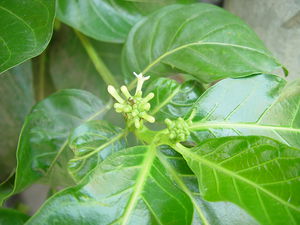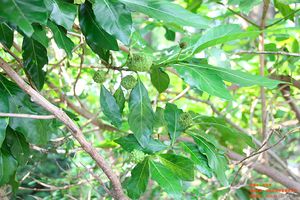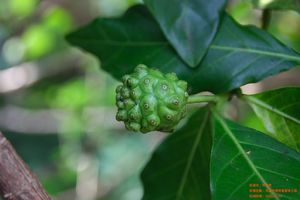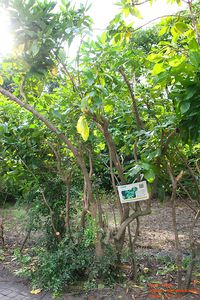檄樹
出自台灣有毒中草藥毒性資料庫
(以內容「http://tcm-toxic.kmu.edu.tw/index.php/大戟科 返回上一頁 {{:模板:基本資料|1=茜草科 Rubiaceae|2=羊角藤屬|3= 'Morinda'|4=檄樹|...」創建新頁面) |
(→毒性分級) |
||
| (8個中途的修訂版本沒有顯示) | |||
| 第1行: | 第1行: | ||
| - | + | __NOTOC__ | |
| + | {| | ||
| + | ||[http://tcm-toxic.kmu.edu.tw/index.php/%E5%AD%B8%E5%90%8D 中英文學名] | ||
| + | |||
| + | ||[http://tcm-toxic.kmu.edu.tw/index.php/%E8%8C%9C%E8%8D%89%E7%A7%91 科別] | ||
| + | |||
| + | ||[http://tcm-toxic.kmu.edu.tw/index.php/%E6%AF%92%E6%80%A7 毒性] | ||
| + | |||
| + | ||[http://tcm-toxic.kmu.edu.tw/index.php/%E7%97%87%E7%8B%80 症狀] | ||
| + | |} | ||
{{:模板:基本資料|1=茜草科 Rubiaceae|2=羊角藤屬|3= 'Morinda'|4=檄樹|5=''Morinda citrifolia'' L.|6=Indian Mulberry, Noni, Great Morinda, ba ji tian, nono, cheese fruit, nhau |7= 海巴戟天 諾麗果 鬼頭果 紅珠樹 水冬瓜 樁根}} | {{:模板:基本資料|1=茜草科 Rubiaceae|2=羊角藤屬|3= 'Morinda'|4=檄樹|5=''Morinda citrifolia'' L.|6=Indian Mulberry, Noni, Great Morinda, ba ji tian, nono, cheese fruit, nhau |7= 海巴戟天 諾麗果 鬼頭果 紅珠樹 水冬瓜 樁根}} | ||
| + | |||
== '''植物圖片''' == | == '''植物圖片''' == | ||
| + | <font size=4> | ||
{| border="2" style="border-collapse;" | {| border="2" style="border-collapse;" | ||
|| | || | ||
| - | [[檔案: | + | [[檔案:檄樹1.JPG |300px|檄樹1]] |
| - | + | 檄樹1 | |
|| | || | ||
| - | [[檔案: | + | [[檔案:IMG_3593.jpg|300px|檄樹2]] |
| - | + | 檄樹2 | |
|| | || | ||
|- | |- | ||
|| | || | ||
| - | [[檔案: | + | [[檔案:IMG_3588.jpg|300px|檄樹3]] |
| - | + | 檄樹3 | |
|| | || | ||
| - | [[檔案: | + | [[檔案:IMG 3603.jpg|200px|檄樹4]] |
| - | + | 檄樹4 | |
| - | | | + | |} |
| - | + | </font> | |
| - | + | ||
| - | + | ||
| - | |||
| - | |||
| - | |||
| - | + | == '''檄樹簡介''' == | |
| - | + | <font size=4> 檄樹最主要的生長地方為南太平洋的群島上,或是一些熱帶地區[1]。主要是被當地居民用於治療疾病,近年來也被用於做為保健食品[2]。</font>。 | |
| - | |||
| - | |||
== '''外觀簡述''' == | == '''外觀簡述''' == | ||
{| border="2" style="border-collapse;" | {| border="2" style="border-collapse;" | ||
|| | || | ||
| - | <font size= | + | <font size=4>'''莖'''</font> |
| - | ||<font size= | + | ||<font size=4>常綠小喬木,高可達7公尺,枝幹平滑,分枝鈍圓四方狀。</font> |
|- | |- | ||
|| | || | ||
| - | <font size= | + | <font size=4>'''葉'''</font> |
| - | ||<font size= | + | ||<font size=4>單葉對生,具短葉柄,長約1.5-2公分。呈橢圓或長橢圓狀,長約10-30公分,寬約5-15公分,葉兩端均尖,葉全緣,正面呈深綠色,背面淺綠色,側脈8-11對。</font> |
|- | |- | ||
|| | || | ||
| - | <font size= | + | <font size=4>'''花'''</font> |
| - | ||<font size= | + | ||<font size=4> 花多數,白色,腋生頭狀花序,花序直徑2-3.5公分,單生,少數2-3枚叢生;花序梗1.5-2.5公分長,無毛,常與葉對生。花萼鐘形,長約0.2-0.35公分;花冠圓筒狀,長約1-1.5公分,先端五裂,冠喉有毛;雄蕊4-5枚,花藥線狀長橢圓,長0.25-0.3公分;花柱1-1.5公分,柱頭2裂。</font> |
|- | |- | ||
|| | || | ||
| - | <font size= | + | <font size=4>'''果實'''</font> |
| - | ||<font size= | + | ||<font size=4> 聚合果,球狀,大小約4-7公分,漿質,一開始為綠色,後轉為黃色,成熟時呈白色或黃綠色,種子多數。</font> |
|} | |} | ||
| + | |||
== '''產地''' == | == '''產地''' == | ||
| - | <font size= | + | <font size=4> 臺灣、東南亞、熱帶亞洲、澳洲及太平洋諸島。長於恆春半島和鄰近島嶼海濱。</font> |
| - | </font> | + | |
== '''毒性研究''' == | == '''毒性研究''' == | ||
| - | <font size= | + | <font size=4> |
1984年,Singh發表了一份研究指出諾麗果在早期多用於促進女性生殖能力,但在2009年歐洲食品安全局(European Food Safety Authority, EFSA)的一份針對諾麗果果汁的評估指出,EFSA並不贊同諾麗果有此種促進女性生殖健康[3]。其他的研究也指出,雖然在毒性評估實驗中,並沒有明顯的生殖毒性或是發育毒性,但仍有一些指標有出現異常,如分娩指數(parturition index),postimplantation losses[4]。
目前亦有案例報導顯示食入諾麗果出現肝臟損傷[5-7],其中有一案例最後必須進行肝臟移植,但仍須在更進一步的研究來證明諾麗果是否確實有肝臟毒性。
另外,由於諾麗果所含的鉀含量相當高,因此研究建議洗腎病患須避免攝食諾麗果,以避免加重腎臟負擔[8]。</font> | 1984年,Singh發表了一份研究指出諾麗果在早期多用於促進女性生殖能力,但在2009年歐洲食品安全局(European Food Safety Authority, EFSA)的一份針對諾麗果果汁的評估指出,EFSA並不贊同諾麗果有此種促進女性生殖健康[3]。其他的研究也指出,雖然在毒性評估實驗中,並沒有明顯的生殖毒性或是發育毒性,但仍有一些指標有出現異常,如分娩指數(parturition index),postimplantation losses[4]。
目前亦有案例報導顯示食入諾麗果出現肝臟損傷[5-7],其中有一案例最後必須進行肝臟移植,但仍須在更進一步的研究來證明諾麗果是否確實有肝臟毒性。
另外,由於諾麗果所含的鉀含量相當高,因此研究建議洗腎病患須避免攝食諾麗果,以避免加重腎臟負擔[8]。</font> | ||
| - | *<font size= | + | *<font size=4 color=green>'''中毒劑量'''</font> <font size=4> |
**小鼠經由腹腔分別注射(intraperitoneally injection, IP)諾麗果水萃取及乙醇萃取液,半數致死劑量(medium lethal death, LD50)分別為7500 mg/kg及3500 mg/kg[9]。</font> | **小鼠經由腹腔分別注射(intraperitoneally injection, IP)諾麗果水萃取及乙醇萃取液,半數致死劑量(medium lethal death, LD50)分別為7500 mg/kg及3500 mg/kg[9]。</font> | ||
| + | |||
=='''毒性分級'''== | =='''毒性分級'''== | ||
| - | <font size= | + | <font size=4>[http://tcm-toxic.kmu.edu.tw/index.php/%E6%AF%92%E6%80%A7%E5%88%86%E9%A1%9E 級數B、等級1]</font> |
== '''參考文獻''' == | == '''參考文獻''' == | ||
| - | 1. Wang MY, Hurn J, Peng L et al. A multigeneration reproductive and developmental safety evaluation of authentic Morinda citrifolia (noni) juice. | + | <font size=4> |
| + | 1. Wang MY, Hurn J, Peng L et al. [http://www.ncbi.nlm.nih.gov/pubmed/21297344 A multigeneration reproductive and developmental safety evaluation of authentic ''Morinda citrifolia'' (noni) juice.] ''Journal of Toxicological Sciences'' 2011; 36: 81-85. | ||
| - | 2. McClatchey W. From Polynesian healers to health food stores: changing perspectives of Morinda citrifolia (Rubiaceae). | + | 2. McClatchey W. [http://www.ncbi.nlm.nih.gov/pubmed/14664736 From Polynesian healers to health food stores: changing perspectives of ''Morinda citrifolia'' (Rubiaceae).] ''Integrative Cancer Therapies'' 2002; 1: 110-120; discussion 120. |
| - | 3. Authority) EEFS. Opinion on the safety of Tahitian Noni® | + | 3. Authority) EEFS. [http://www.efsa.europa.eu/de/efsajournal/pub/998.htm Opinion on the safety of Tahitian Noni® ‘''Morinda citrifolia'' (noni) fruit puree and concentrate’ as a novel food ingredient.] ''The EFSA Journal'' 2009; 998: 1-16. |
| - | 4. Muller JC, Botelho GG, Bufalo AC et al. Morinda citrifolia Linn (Noni): in vivo and in vitro reproductive toxicology. Journal of Ethnopharmacology 2009; 121: 229-233. | + | 4. Muller JC, Botelho GG, Bufalo AC et al. [http://www.ncbi.nlm.nih.gov/pubmed/19015020 ''Morinda citrifolia'' Linn (Noni): in vivo and in vitro reproductive toxicology.] ''Journal of Ethnopharmacology'' 2009; 121: 229-233. |
| - | 5. Yu EL, Sivagnanam M, Ellis L, Huang JS. Acute hepatotoxicity after ingestion of Morinda citrifolia (Noni Berry) juice in a 14-year-old boy. | + | 5. Yu EL, Sivagnanam M, Ellis L, Huang JS. [http://www.ncbi.nlm.nih.gov/pubmed/21119544 Acute hepatotoxicity after ingestion of ''Morinda citrifolia'' (Noni Berry) juice in a 14-year-old boy.] ''Journal of Pediatric Gastroenterology Nutrition'' 2011; 52: 222-224. |
| - | 6. Stadlbauer V, Fickert P, Lackner C et al. Hepatotoxicity of NONI juice: report of two cases. World | + | 6. Stadlbauer V, Fickert P, Lackner C et al. [http://www.ncbi.nlm.nih.gov/pubmed/16094725 Hepatotoxicity of NONI juice: report of two cases.] ''World Journal of Gastroenterology'' 2005; 11: 4758-4760. |
| - | 7. Millonig G, Stadlmann S, Vogel W. Herbal hepatotoxicity: acute hepatitis caused by a Noni preparation (Morinda citrifolia). | + | 7. Millonig G, Stadlmann S, Vogel W. [http://www.ncbi.nlm.nih.gov/pubmed/15756098 Herbal hepatotoxicity: acute hepatitis caused by a Noni preparation (''Morinda citrifolia'').] ''European Journal of Gastroenterology & Hepatology'' 2005; 17: 445-447. |
| - | 8. Burrowes JD, Van Houten G. Use of alternative medicine by patients with stage 5 chronic kidney disease. | + | 8. Burrowes JD, Van Houten G. [http://www.ncbi.nlm.nih.gov/pubmed/16010646 Use of alternative medicine by patients with stage 5 chronic kidney disease.] ''Advances in Chronic Kidney Disease'' 2005; 12: 312-325. |
| - | 9. Chearskul S, Kooptiwut S, Chatchawalvanit S et al. Morinda | + | 9. Chearskul S, Kooptiwut S, Chatchawalvanit S et al. [http://www.google.com/url?sa=t&rct=j&q=&esrc=s&source=web&cd=1&ved=0CCoQFjAA&url=http%3A%2F%2Fwww.j-pbs.org%2Fpdf%2F171%2Fchearskul.pdf&ei=QJDbTsSXEsnrmAWU69TkCQ&usg=AFQjCNHgVvdeqJ_jLtKLexxgNEPEr0_IxQ&sig2=ShMRVBBVJXFp3W9QgC0wYQ ''Morinda citrifolia'' has very weak estrogenic activity in vivo.] ''Tahi Journal of Physiological Sciences'' 2004; 17: 22-29. |
| + | </font> | ||
| + | {| | ||
| + | ||[http://tcm-toxic.kmu.edu.tw/index.php/%E5%AD%B8%E5%90%8D 中英文學名] | ||
| - | [http://tcm-toxic.kmu.edu.tw/index.php/% | + | ||[http://tcm-toxic.kmu.edu.tw/index.php/%E8%8C%9C%E8%8D%89%E7%A7%91 科別] |
| + | |||
| + | ||[http://tcm-toxic.kmu.edu.tw/index.php/%E6%AF%92%E6%80%A7 毒性] | ||
| + | |||
| + | ||[http://tcm-toxic.kmu.edu.tw/index.php/%E7%97%87%E7%8B%80 症狀] | ||
| + | |} | ||
在2012年10月25日 (四) 02:27的最新修訂版本
| 中英文學名 | 科別 | 毒性 | 症狀 |
基本資料
|
科別 | 茜草科 Rubiaceae |
|
屬名 | 羊角藤屬 Morinda |
|
中文學名 | 檄樹 |
|
拉丁學名 | Morinda citrifolia L. |
|
英文名稱 | Indian Mulberry, Noni, Great Morinda, ba ji tian, nono, cheese fruit, nhau |
|
中文俗名 | 海巴戟天 諾麗果 鬼頭果 紅珠樹 水冬瓜 樁根 |
植物圖片
|
檄樹1 |
檄樹2 | |
|
檄樹3 |
檄樹4 |
檄樹簡介
檄樹最主要的生長地方為南太平洋的群島上,或是一些熱帶地區[1]。主要是被當地居民用於治療疾病,近年來也被用於做為保健食品[2]。。
外觀簡述
|
莖 | 常綠小喬木,高可達7公尺,枝幹平滑,分枝鈍圓四方狀。 |
|
葉 | 單葉對生,具短葉柄,長約1.5-2公分。呈橢圓或長橢圓狀,長約10-30公分,寬約5-15公分,葉兩端均尖,葉全緣,正面呈深綠色,背面淺綠色,側脈8-11對。 |
|
花 | 花多數,白色,腋生頭狀花序,花序直徑2-3.5公分,單生,少數2-3枚叢生;花序梗1.5-2.5公分長,無毛,常與葉對生。花萼鐘形,長約0.2-0.35公分;花冠圓筒狀,長約1-1.5公分,先端五裂,冠喉有毛;雄蕊4-5枚,花藥線狀長橢圓,長0.25-0.3公分;花柱1-1.5公分,柱頭2裂。 |
|
果實 | 聚合果,球狀,大小約4-7公分,漿質,一開始為綠色,後轉為黃色,成熟時呈白色或黃綠色,種子多數。 |
產地
臺灣、東南亞、熱帶亞洲、澳洲及太平洋諸島。長於恆春半島和鄰近島嶼海濱。
毒性研究
1984年,Singh發表了一份研究指出諾麗果在早期多用於促進女性生殖能力,但在2009年歐洲食品安全局(European Food Safety Authority, EFSA)的一份針對諾麗果果汁的評估指出,EFSA並不贊同諾麗果有此種促進女性生殖健康[3]。其他的研究也指出,雖然在毒性評估實驗中,並沒有明顯的生殖毒性或是發育毒性,但仍有一些指標有出現異常,如分娩指數(parturition index),postimplantation losses[4]。 目前亦有案例報導顯示食入諾麗果出現肝臟損傷[5-7],其中有一案例最後必須進行肝臟移植,但仍須在更進一步的研究來證明諾麗果是否確實有肝臟毒性。 另外,由於諾麗果所含的鉀含量相當高,因此研究建議洗腎病患須避免攝食諾麗果,以避免加重腎臟負擔[8]。
- 中毒劑量
- 小鼠經由腹腔分別注射(intraperitoneally injection, IP)諾麗果水萃取及乙醇萃取液,半數致死劑量(medium lethal death, LD50)分別為7500 mg/kg及3500 mg/kg[9]。
毒性分級
參考文獻
1. Wang MY, Hurn J, Peng L et al. A multigeneration reproductive and developmental safety evaluation of authentic Morinda citrifolia (noni) juice. Journal of Toxicological Sciences 2011; 36: 81-85.
2. McClatchey W. From Polynesian healers to health food stores: changing perspectives of Morinda citrifolia (Rubiaceae). Integrative Cancer Therapies 2002; 1: 110-120; discussion 120.
3. Authority) EEFS. Opinion on the safety of Tahitian Noni® ‘Morinda citrifolia (noni) fruit puree and concentrate’ as a novel food ingredient. The EFSA Journal 2009; 998: 1-16.
4. Muller JC, Botelho GG, Bufalo AC et al. Morinda citrifolia Linn (Noni): in vivo and in vitro reproductive toxicology. Journal of Ethnopharmacology 2009; 121: 229-233.
5. Yu EL, Sivagnanam M, Ellis L, Huang JS. Acute hepatotoxicity after ingestion of Morinda citrifolia (Noni Berry) juice in a 14-year-old boy. Journal of Pediatric Gastroenterology Nutrition 2011; 52: 222-224.
6. Stadlbauer V, Fickert P, Lackner C et al. Hepatotoxicity of NONI juice: report of two cases. World Journal of Gastroenterology 2005; 11: 4758-4760.
7. Millonig G, Stadlmann S, Vogel W. Herbal hepatotoxicity: acute hepatitis caused by a Noni preparation (Morinda citrifolia). European Journal of Gastroenterology & Hepatology 2005; 17: 445-447.
8. Burrowes JD, Van Houten G. Use of alternative medicine by patients with stage 5 chronic kidney disease. Advances in Chronic Kidney Disease 2005; 12: 312-325.
9. Chearskul S, Kooptiwut S, Chatchawalvanit S et al. Morinda citrifolia has very weak estrogenic activity in vivo. Tahi Journal of Physiological Sciences 2004; 17: 22-29.
| 中英文學名 | 科別 | 毒性 | 症狀 |



